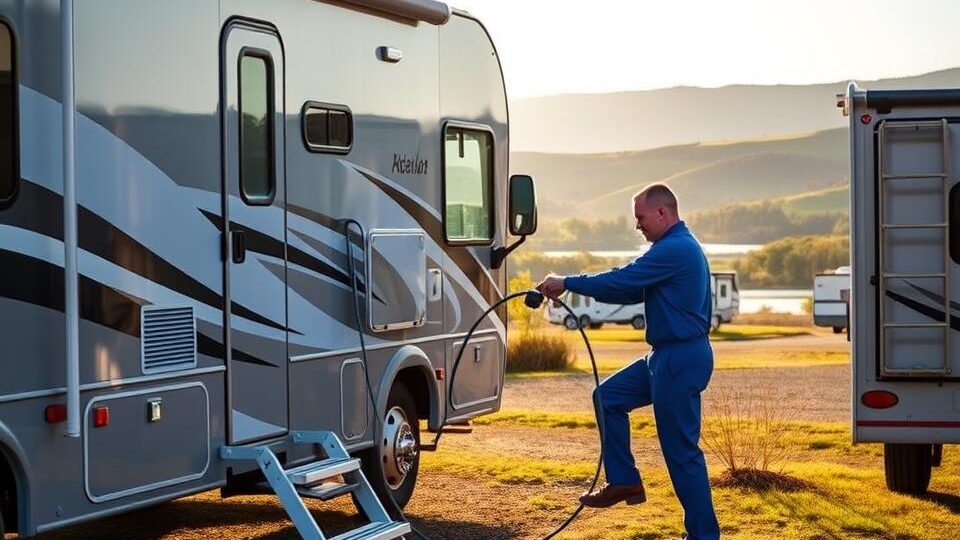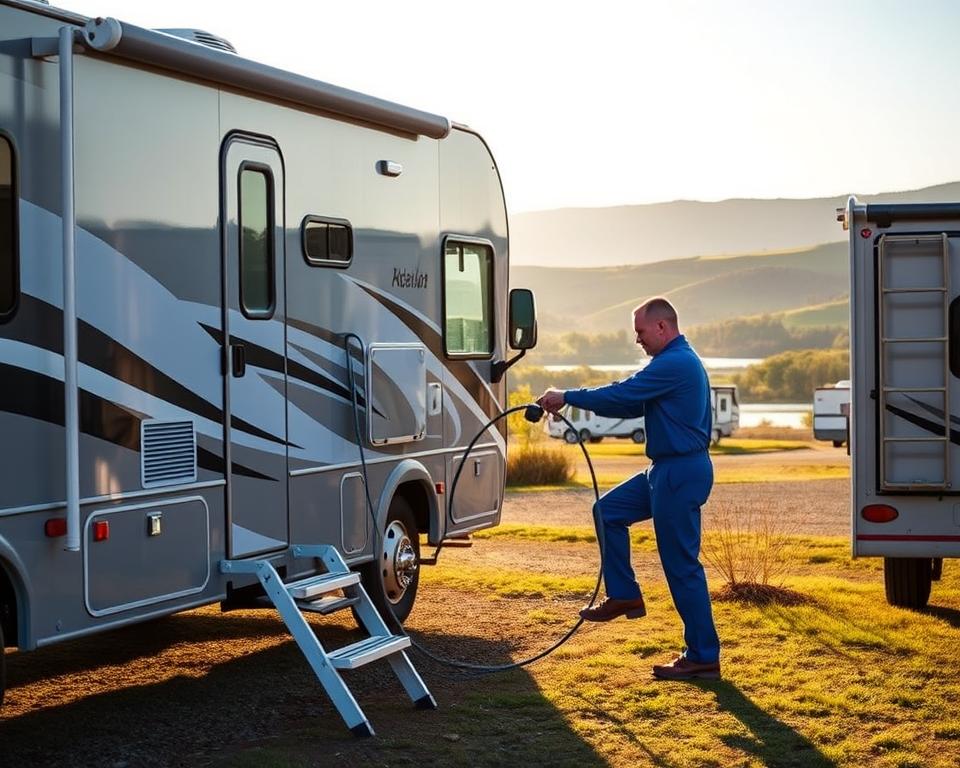
Finding RV Holding Tank Pump Out Service Near Me with Flexible Hours (San Fernando)
RV Septic Tank Service: Essential Care Tips
Have you ever considered what happens to your RV’s Septic tank when you’re traveling? It’s not just dodging unpleasant scents. Maintaining your RV Septic tank in good shape ensures hassle-free trips. A regularly serviced system halts messy situations and costly repairs. However, many overlook this critical care. Through this guide, we break down the necessity for regular RV sewage pump. We’ll spotlight why maintenance matters and offer tips for servicing your recreational vehicle’s Septic tank. Prepare for carefree adventures!
Key Highlights
- Scheduled RV Septic tank service is essential for top performance.
- Grasping your RV Septic system helps avoid costly repairs.
- Preventive maintenance wards off unpleasant odors and clogs.
- Establish a pumping schedule suited to your usage.
- Practice best practices for emptying your holding tanks.
- Avoid common mistakes to lengthen the life of your Septic system.
- Know when to call for professional help for Septic services.
Understanding RV Septic Systems
An RV Septic system is key for any camper. It includes multiple holding tanks that handle waste efficiently. You’ll find three main tanks in an RV: the fresh water, the gray, and the black tank. The fresh water tank delivers clean water for drinking and cooking. Meanwhile, the gray tank stores wastewater from sinks and showers, maintaining cleanliness. The black tank, specifically for toilet waste, also has a vent to cut odors.
Preserving a healthy camper sewage system calls for recognizing how these parts interact. Frequent checks of the tank levels are essential to avoid overflow and secure everything runs properly. Getting to know the termination valves is important too. These valves are key in properly directing waste disposal. By understanding these components, you can keep your RV in great shape and relish your travels without any unnecessary trouble.
| Holding Tank | Function | Typical Size |
|---|---|---|
| Fresh Water Tank | Supplies drinking and cooking water | 30-100 gallons |
| Gray Tank | Stores wastewater from sinks and showers | 30-60 gallons |
| Black Tank | Stores toilet waste | 30-50 gallons |
Importance of Regular RV Septic Tank Service
Timely RV Septic tank service is central to ensuring your system efficient and long-lasting. Without adequate maintenance, you could face system failures, bad smells, and pricey repairs—issues that interrupt your adventures.
Overlooking the upkeep of your RV’s Septic system may cause it to back up. This not only impacts your RV’s function but also your comfort levels. A clean and regularly cleaned system is essential for hassle-free trips, offering you a peaceful travel experience.

Regular maintenance lengthens your sewage system’s lifespan and keeps a clean living space. Keeping an eye on your Septic tank helps you catch issues early. This proactiveness reduces costs and stress, giving you confidence during your journeys.
Frequency of RV Septic Tank Pumping
Figuring out the right schedule for RV Septic tank maintenance is based on the vehicle’s usage. For those constantly on the road or residing in their RVs, it’s wise to drain the black tank every 3–5 days. This practice maintains cleanliness and stops unexpected issues during voyages.
Weekend adventurers can typically wait until they return home to pump their Septic tank. Keeping waste in the tank too long, though, can cause build-up that impedes the tank’s function and smell control. It’s important to watch the tank’s level closely, get ready for disposal once it hits two-thirds full to keep everything running properly.
The capacity of your Septic system, along with how you use your RV, will guide when to pump. Understanding these aspects improves your RV’s performance and cuts the dangers of poor waste management.
| Usage Pattern | Recommended Pumping Frequency | Urgent Pumping Indicators |
|---|---|---|
| Frequent Usage | Every 3-5 days | Reaches 66% capacity |
| Weekend Trips | After return home | Bad smells or slow drainage |
| Extended Trips | Every 2-3 days | Sight glass shows full |
How to Empty RV Holding Tanks Properly
Efficiently managing a recreational vehicle’s holding tanks is crucial for a pleasant camping experience. Always start by draining the black tank first. This method allows the gray water to flow through and rinse out the hose. Be sure the use of a high-quality sewer hose for a tight connection and to minimize spills. Once the tanks are emptied, fully flushing the black tank is vital. Running a built-in black tank flush or comparable alternatives can dramatically cut residue.
After the emptying process, it’s critical to close both valves firmly. This action is important to maintain a fully operational Septic system. Additionally, RV owners must utilize dump stations properly and follow local laws. Routine cleaning practices for recreational vehicle Septic tanks are essential. They protect the system’s optimal functionality and avoid future odors.
How to Stop RV Odors & Clogs
To tackle odors and prevent clogs in your RV, attention to detail is crucial. The task starts with verifying enough water in the holding tanks. Adequate water helps in breaking down waste properly, reducing bad smells.
Picking suitable toilet paper is important in this process. Opt for RV-safe toilet paper that breaks down quickly, preventing clogs. This minor adjustment considerably supports maintaining seamless waste flow.
Applying enzyme-based treatments can further boost waste decomposition and odor control. These bio solutions assist keep your RV smelling fresh. It’s also crucial to regularly examine vent pipes for obstructions to ensure good airflow and stop odors from infiltrating your living area.
RV Septic Maintenance: Mistakes to Avoid
Looking after your RV’s Septic system the right way is crucial for its efficiency and longevity. When non-biodegradable items like wipes or feminine products are flushed, they can cause significant blockages. These blockages can cause various problems that are challenging to resolve.
Not using enough water when flushing can also harm the system. It causes waste buildup, resulting in nasty scents and potential damage. Furthermore, a common mistake at full hook-up sites is leaving the black tank valve open. This causes waste to accumulate at the tank’s bottom.
Preventive measures include consistently flushing and rinsing tanks after emptying them. Ignoring maintenance can escalate into significant issues requiring pricey repairs. Being ahead of the game and knowledgeable protects both your RV and your finances.
Calling in the Pros for RV Septic Service
Understanding when to seek professional RV Septic services is crucial for maintaining a healthy Septic system. Some indicators suggest the need for expert intervention. If you notice slow-draining tanks or get persistent foul odors emanating from your RV, it is prudent to act promptly. These signs often reveal underlying issues that need a thorough Septic tank service for resolution.
Visible leftover waste after emptying can also show problems within your Septic system. This situation may not resolve with routine maintenance and may necessitate the use of specialized equipment. Professionals are equipped to tackle complex challenges via tools, such as high-pressure water jets, to provide a complete cleaning process.
Prompt professional assistance can make a significant difference. Minor troubles can quickly turn into more severe complications without proper care. Investing in professional RV Septic services helps the integrity of your system and lengthens its lifespan.
| Problem Indicators | What to Do |
|---|---|
| Slow draining tanks | Contact professional RV Septic services for assessment |
| Persistent foul odors | Schedule Septic tank service for diagnostics |
| Visible leftover waste | Seek immediate assistance from a professional |
| Frequent clogs | Consider expert cleaning solutions |
Sustaining RV Septic Performance Over Time
Long-term care for RV Septic systems requires attention past basic pump-outs. Carrying out deep cleaning of tanks every few months stops buildup and prolongs system life. Checking dump valve seals regularly avoids leaks. Additionally, sanitizing the system keeps it clean and functioning well.
It’s important to monitor tank sensors to verify they work correctly. Incorrect readings may result in over-filling, impacting performance. Routine sensor checks and tweaking maintenance schedules can stop this problem.
| Maintenance Task | How Often | Outcome |
|---|---|---|
| Deep Cleaning Tanks | Every 3-6 months | Keeps flow smooth |
| Inspect Dump Valve Seals | Monthly | Prevents drips |
| Sanitize System | Every 6 months | Makes sure system remains clean |
| Monitor Tank Sensors | Monthly | Prevents over-fill |
Proactive maintenance is key to your RV Septic system’s long-term health. It creates smooth and trouble-free travel experiences.
All In Sanitation: Trusted RV Septic Partner
All In Sanitation excels at delivering RV Septic services that match each client’s unique needs. Whether it’s scheduled pump-outs or thorough tank cleaning, they understand the essential role of a well-functioning Septic system in your RV’s performance.
Boasting extensive expertise in RV Septic systems, All In Sanitation provides top-tier guidance on maintenance and care. Their team is well-versed in the particular challenges RV owners face and offers effective solutions when troubles arise.
Opting for All In Sanitation enables RV enthusiasts fully engage in their journeys, entrusting Septic concerns to a dependable ally. Their dedication to excellent service provides peace of mind and boosts the pleasure of adventures on the open road.
Conclusion
Maintaining your RV Septic tank is vital for hassle-free travels. It’s important to understand your system and adhere to regular services. This secures you won’t face unexpected issues on your journey. These key steps cover frequent pumping and adopting sound waste management practices.
Proper long-term care keeps your system in prime form. By following the provided maintenance tips, you can boost your travel experience. This strategy helps avoid expensive repairs later. Remember, steering clear of common errors and knowing when to get professional help are important.
In the end, being proactive in your RV Septic system’s maintenance secures a hassle-free adventure. It enables you to zero in on forming lasting memories. So, take these steps to heart and savor your road trips to their fullest.